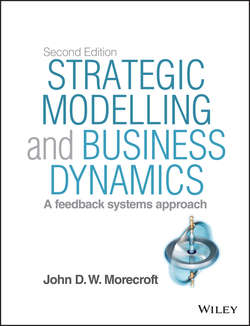Читать книгу Strategic Modelling and Business Dynamics - Morecroft John D. - Страница 12
На сайте Литреса книга снята с продажи.
Preface from the First Edition 3
The Dynamics of Strategy
ОглавлениеAround 1995, I began working with Kim Warren on the dynamics of strategy. This development was motivated by our shared interest in strategy (we were both in the Strategy department at the time) and also by our familiarity with a widely cited paper in the academic management literature entitled ‘Asset stock accumulation and sustainability of competitive advantage’. The paper was written by INSEAD's Ingemar Dierickx and Karel Cool and appeared in Management Science in 1989. Their argument was that the sustainability of firms' competitive advantage could be better understood by thinking about the way firms accumulate the asset stocks or resources that underpin their business. A firm might achieve competitive advantage by building a distinctive set of asset stocks that rivals would find difficult to imitate. Sustainability of competitive advantage would stem in part from the time it takes to accumulate or reconfigure such assets or resources. We realised that here was a dynamic view of firm performance that could be further developed by formally linking system dynamics with the resource-based view of the firm (an important branch of contemporary strategy theory and practice).
Our way of carrying out this synthesis was to jointly design and launch an MBA elective course at London Business School, which we called the Dynamics of Strategy. Applied research projects followed, including PhD theses at London Business School by Edoardo Mollona, Shayne Gary, Abhijit Mandal and Martin Kunc.
Dynamic resource-based models of the firm were devised to study important strategy topics such as diversification and competitive advantage. The research partners for doctoral projects included François Delauzun from BBC World Service and Bill Howieson from Scottish Power. Another partnership was with the London Office of McKinsey & Co., during 1996–2000, when the Business Dynamics practice was in full swing. The company assembled a strong team of consultants with expertise in modelling, and they provided a sounding board for many fledgling ideas about system dynamics and strategy. My thanks to Andrew Doman who led the Business Dynamics initiative in London and to Maurice Glucksman, Paul Langley, Norman Marshall, Panos Ninios and Hendrick Sabert who collaborated with London Business School on a variety of projects and publications.
There are samples of this strategy dynamics work on the Learners' website and in the book. See in particular the materials on People Express Airlines in the learning support folder for Chapter 6 and the materials on diversification dynamics and metamorphosis in the v-Lecture folders. Also, Chapter 10 includes edited extracts from Martin Kunc's dissertation about product growth dynamics and industry competition in fast moving consumer goods. Kim Warren went on to further develop the SD-RBV theme in his Forrester Award-winning book, Competitive Strategy Dynamics.
